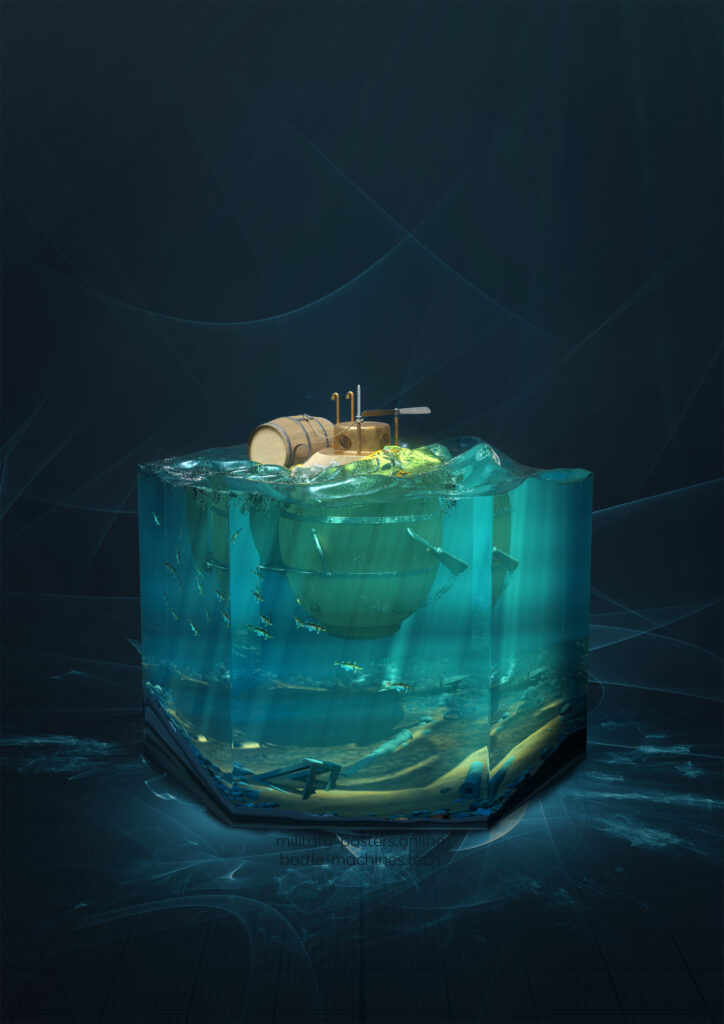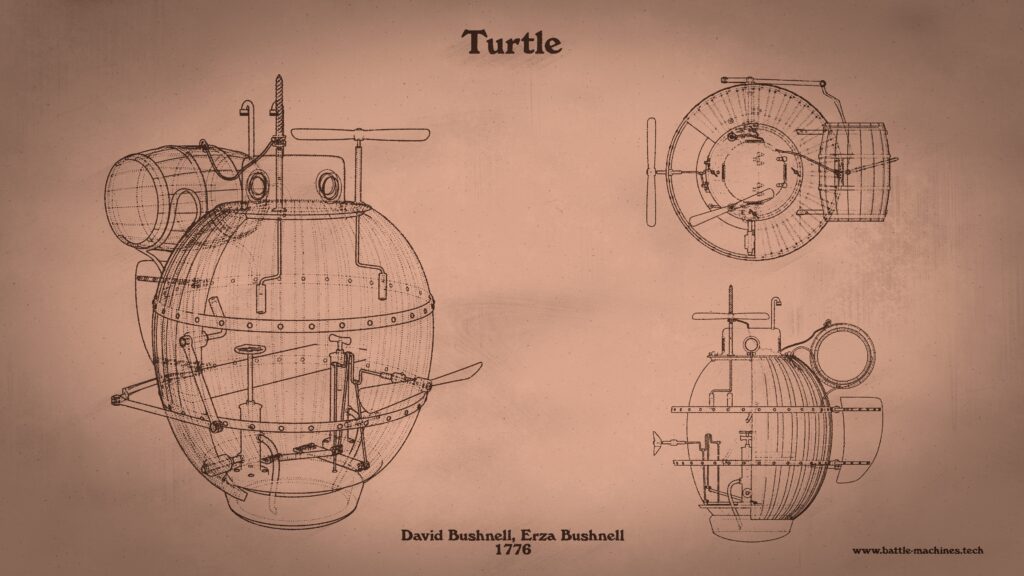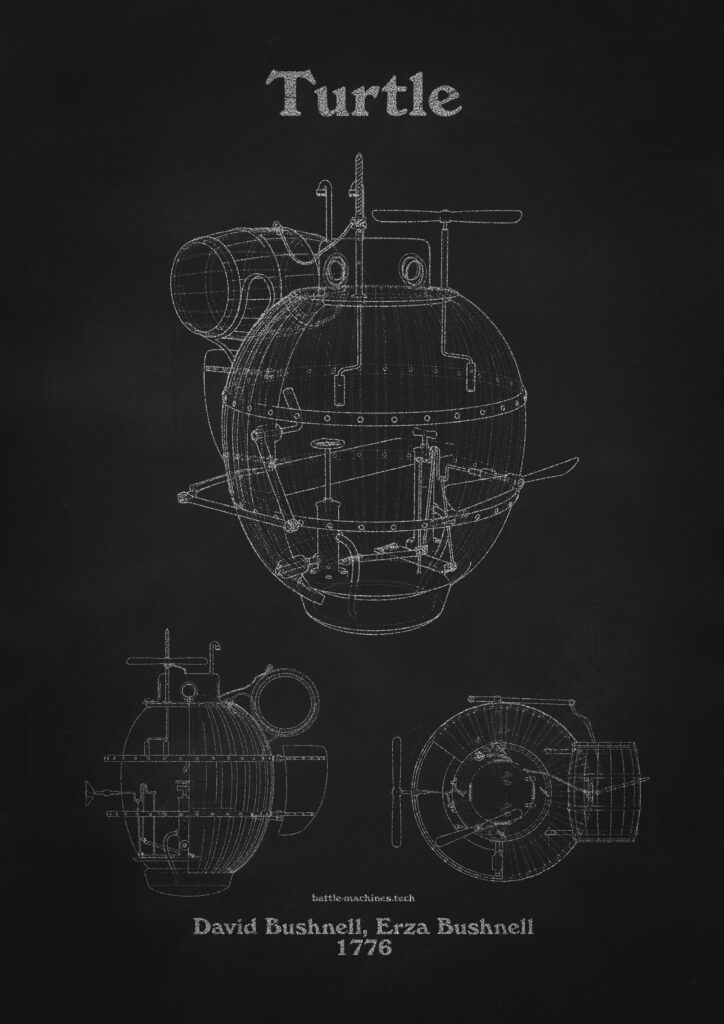Turtle Submarine – 1st Submarine Attack Ever Visualized
Treat yourself and support the project: https://battle-machines.tech/artworks/
In this video, I’m going to show you the first military submarine ever. It is called “Turtle” and its military design was ingenious.
Introduction
This story is about the first submarine attack ever. Was the first military submarine successful? How did it work?
Historians are not sure when Bushnell and his brother Ezra began construction of the submarine that launched in the fall of 1776 and became known as the Turtle. It had to carry and deliver an underwater mine. For that, they had to solve many problems—how to supply light and air for the craft, how to gauge direction and depth during operation—and they had to solve them quickly.
How it work

The hull of the submarine was constructed of oak, somewhat like a barrel, and bound by heavy wrought-iron hoops. This was the age of wood, and barrels and ships’ hulls were made everywhere. However, all of the mechanical parts needed for the submarine required the involvement of highly skilled, experienced artisans and crafters.
To submerge and raise the vessel, the operator flooded the air-filled chamber with water, making it heavier or lighter as needed, to achieve the desired depth.
Ballast, which is the stabilizing weight needed to keep the boat upright in the water, was affixed to the outside bottom.
To propel the boat forward and backwards, Bushnell used a front propeller that was operated by a treadle and a crank.
A vertical propeller on the top of the boat assisted with the ascent. These two propellers that Bushnell invented and described as “oars” and “like the blades of a windmill”
Turtle turns using rudder connected to simple lever mechanism.
Operating this machine was very difficult. Not to mention the courage of the operator.
Air came into the chamber through two snorkels that closed over when the boat submerged. Because the air inside the submarine was limited by its size, the vessel was designed to travel on the surface with its hatch and windows above water. It would only submerge to avoid detection and affix the mine.
The only light that came into the dark vessel was through the small windows in the hatch.
Mine

The underwater mine Bushnell designed was probably keg shaped, packed with 60 kilograms of gunpowder, it could put a hole in the hull of a large British warship.
Igniting the gunpowder underwater presented a challenge, as did timing the explosion so that the Turtle and its operator could get safely away.
The team modified a clockwork timing device to trigger a flintlock mechanism from a musket. The sparks made by flint striking steel would ignite the priming powder in the pan that in turn would set off the gunpowder. The operator would set the timing device in motion when releasing the mine from the submarine, allowing him enough time to clear the area.
The Plan
The plan was to get under flagship, attach a mine to the hull and escape. Easy. …or not?
Did they succeed?
On a late summer night in 1776, Sargent Lee slowly fought his way toward the HMS Eagle. Once within clear view of HMS Eagle, he slowly submerged and crept underneath the big ship’s stern, towards its rudder area. Here began his attempt to drill into the Eagle so that the mine could be attached. Exhausted, Lee kept trying to break through what seemed like an impenetrable metal barrier. At that time He didn’t know that this was the iron plating around the ship’s rudder hinge system.
Lee eventually gave up on the attack and made his way back out into the Hudson channel. He says that he was spotted by the British as he left. He released the mine, which resulted in a massive explosion sending water high into the air.
Conclusion
Although the American Turtle was deemed a failure, it was a successful one. Even George Washington described the Turtle as an “effort of genius.” Obviously, Mr Bushnell was onto something as submarine warfare would become one of the most effective weapons of the 20th Century. Yet it would take almost a century for the technology to advance far enough for a submarine to execute a successful kill by on another ship. In 1864, during the Civil War, the Confederate Navy’s submarine H.L. Hunley became the first militarized submarine to sink an enemy ship. And this is the topic for one of the future videos.
Download Turtle Submarine high-resolution freeposters and wallpapers. There are also 3D models for interior designers.
And don’t forget that there is also the possibility of buying high-quality products with this theme. By purchasing any of them you will support this project.





Turtle Submarine Patent Art Blackboard Landscape

Turtle Submarine Patent Art Sephia Paper Landscape

Turtle Submarine Patent Art Blackboard Landscape

Turtle Submarine Patent Art Sephia Paper Portrait
| Download military wallpapers and other military images in patent art or 3D artwork. For a large high-quality military poster about military history and military technology please check one of the stores. |
To allow walking you have to click on the image, even if the cursor is not visible.
WASD = move, Mouse = look, Space = jump, Esc = exit
Works fine on PC, just need to add controls for touch screens and polish the design.
I’ve spent some time on this and it’s beyond my knowledge. Therefore, I decided to focus on creating new interesting posts and artworks, instead of devoting more time to this.
If you know how to do it and you are willing to help me, I will not be the only one who will be grateful to you. Definitely, all visitors will.
I simply can’t resist to make it.
Simple to set it up, hard to compute. That’s OK. Let machines do their job.
Simulation statistics:
- Baking time: ~250 hours using 20 threads of 1st. gen. Threadripper
- Project size: ~480GB
- Render time: ~160 hours using two GTX 1070 + RTX 2070 Super overnights
- RAM usage: 40-50GB Grid resolution: 350 (it crash after a few hours with res 400. I believe due to RAM overload)
- Software: Blender, FLIP Fluids, E-Cycles, Da Vinci Resolve, Soundly
